ESP AUDI R8 SPYDER 2014 User Guide
[x] Cancel search | Manufacturer: AUDI, Model Year: 2014, Model line: R8 SPYDER, Model: AUDI R8 SPYDER 2014Pages: 244, PDF Size: 61.06 MB
Page 38 of 244
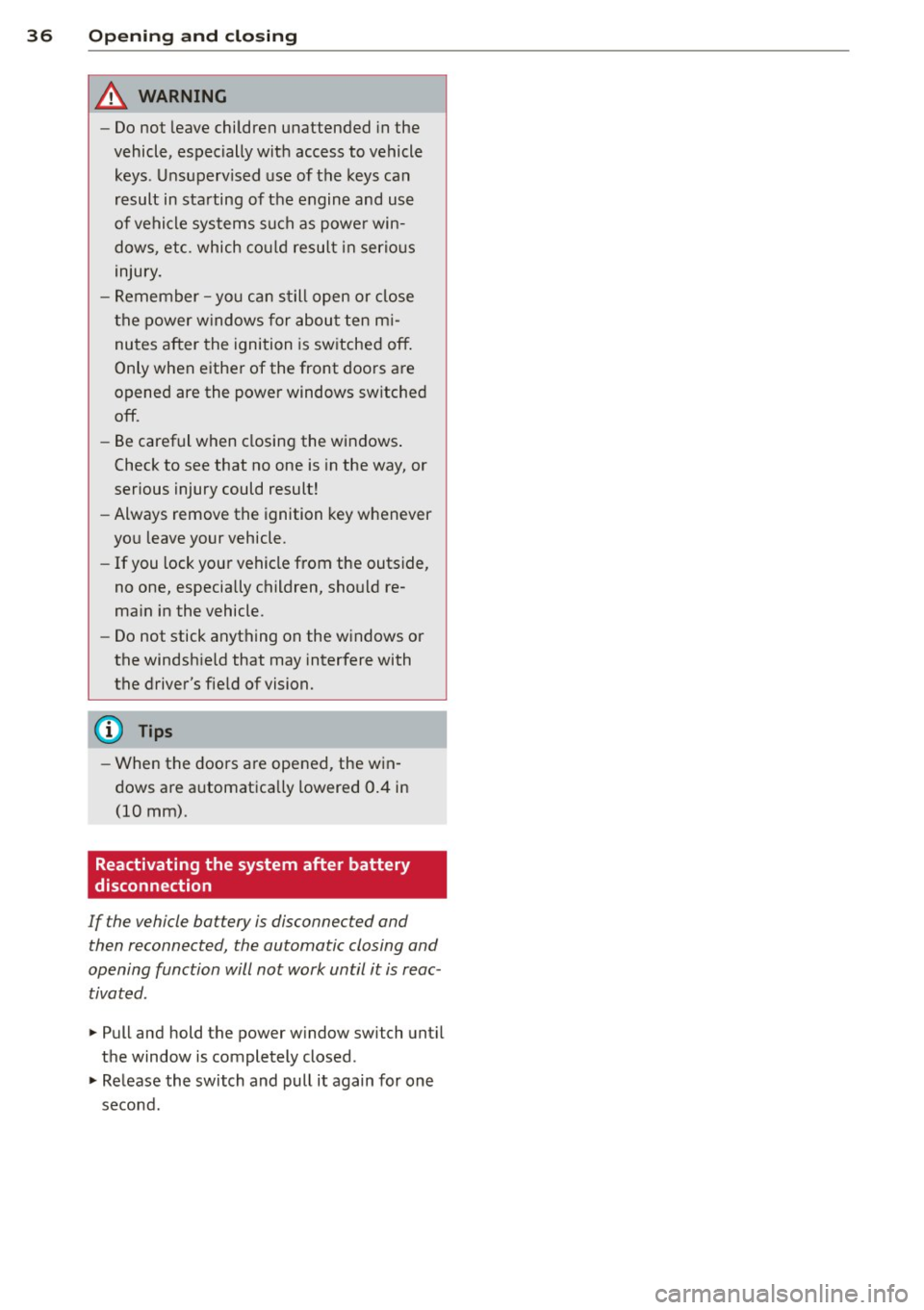
36 Openin g and clo sing
A WARNING
- Do not leave children unattended in the
vehicle, especially with access to vehicle
keys . Unsupervised use of the keys can
result in starting of the engine and use
of vehicle systems such as powe r win
dows , etc. which cou ld result in serio us
injury.
- Remember -you can still open or close
the power w indows for abou t ten m i
nutes after the ignition is sw itched off .
Only when either of the front doors are
opened are the power windows switched
off.
- Be careful when closing the windows .
Check to see that no one is in the way, or
serious injury could result!
- Always remove the ignition key whenever
you leave your vehicle.
- If you lock your vehicle from the outside,
no one, especia lly children, sho uld re
ma in in the vehicle .
- Do not stick anything on the windows or
the windsh ield that may interfere with
the driver's fie ld of vision.
@ Tips
- When the doors are opened, the w in
dows are a utomatica lly lowered 0.4 in
(10 mm) .
Reactivating the system after battery
disconnection
If the vehicle ba ttery i s disconnected and
then reconnected, the automatic closing and
opening function will not work until it is reac
tivated .
• Pull and hold the power w indow swi tch un til
the window is completely clo sed .
• Release the switch and pull it again for one
second.
Page 39 of 244
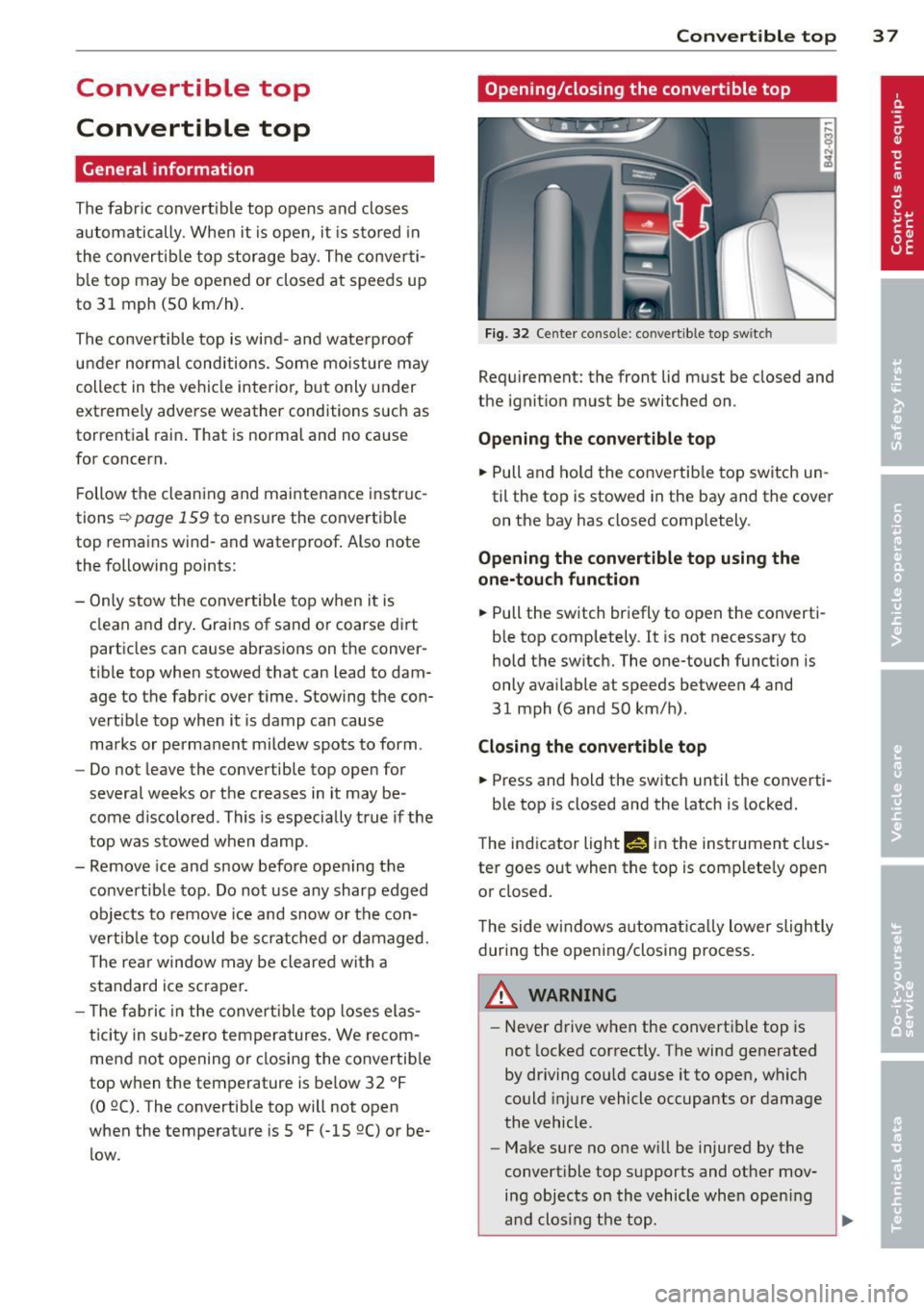
Convertible top
Convertible top
General information
The fabric convertible top opens and closes
automatically . When it is open, it is stored in
the convertible top storage bay. The converti
b le top may be opened or closed at speeds up
to 31 mph (SO km/h) .
The convertible top is wind- and waterproof
under normal conditions. Some moisture may
collect in the vehicle interior, but only under
extreme ly adverse weather conditions such as
torrential rain. That is normal and no cause
for concern.
F ollow the clean ing and maintenance instruc
tions
Q page 159 to ensure the convertible
top remains wind- and waterproof . Also note
the following points:
- Only stow the convert ible top when it is
clean and dry . Grains of sand or coarse dirt
particles can cause abrasions on the conver
tible top when stowed that can lead to dam
age to the fabric over time. Stowing the con
vertible top when it is damp can cause
marks or permanent mildew spots to form .
- Do not leave the convertible top open for
several weeks or the creases in it may be
come discolored . This is especia lly true if the
top was stowed when damp .
- Remove ice and snow before opening the
convertible top. Do not use any sharp edged
objects to remove ice and snow or the con
vertible top could be scratched or damaged.
The rear window may be cleared with a
standard ice scraper.
- Th e fabric in the convertible top loses elas
t icity in sub-zero temperatures. We recom
mend not opening or closing the convertible
top when the temperature is below 32 °F
(0 QC). The convertib le top will not open
when the temperature is 5 °F (-15
Q() or be
low .
Convertible top 3 7
Opening/closing the convertible top
Fig. 32 Center console: convertible top switc h
Requ irement: the front lid must be closed and
the ignition must be switched on .
Opening the convertible top
... Pull and hold the convertib le top switch un
til the top is stowed in the bay and the cover
on the bay has closed completely .
Opening the convertible top using the
one-touch function
... Pull the switch briefly to open the converti
ble top comp letely.
It is not necessary to
hold the switch. The one-touch function is
only available at speeds between 4 and
31 mph (6 and 50 km/h) .
Closing the convertible top
... Press and hold the switch until the converti-
ble top is closed and the latch is locked.
T he ind icator light Nin the instrument clus
ter goes out when the top is complete ly open
or closed.
The side windows a utomat ically lower slightly
during the opening/closing process.
A WARNING
-Never drive when the convert ible top is
not locked correctly. The wind generated
by driving cou ld cause it to open, which
could injure vehicle occupants or damage
the vehicle .
- Make sure no one will be injured by the
convert ible top supports and other mov
ing objects on the vehicle whe n opening
a nd clos ing the top.
Page 49 of 244

shown as active in the driver information
system.
The
coming home function illuminates the
area around the vehicle when the ignition is
switched off and the driver 's door is opened.
The length of time the lights rema in on can be
set in the menu display
(Lights> Exterior
lights> coming home) .
The leaving home function illuminates the
area around the vehicle when unlock ing it.
A WARNING
- Never use daytime running lights to see
where you are going. They are not bright enough and will not let you see far
enough ahead for safety, especially at
dusk or when it is dark . Be aware of
changes in outside light conditions when
you are driving and respond by switching
on your low beams.
- Automatic head- and taillight control is
only intended to assist the driver. This
feature does not relieve the driver of his
responsibility to check the headlights
and to turn them on manually according
to the current light and visibility condi
tions. For example, fog and rain cannot
be detected by the light sensors. Conse
quently, always switch the headlights on
under these weather conditions and
when driving in the dark.
- Crashes can happen when you cannot see
the road ahead and when you cannot be
seen by other motorists .
-Always turn on the headlights so that you can see ahead and so that others can see your car from the back.
- Please observe legal regulations when
using the light ing systems descr ibed .
@ Tips
-Always observe the specific local regula
tions for your area when to use your
lights .
- Turn on low beams as evening ap
proaches or in conditions of poor visibili
ty. Clear vision 4
7
- Do not attach stickers to the windshield
in front of the sensors as this can disable
the automatic head- and taillight control
and the automatic glare-dimming of the
rearview mirror(s)*.
- If you remove the ignition from the igni
tion lock while the headlights are still
on, a buzzer will sound as long as the
driver's door is open to remind you to
turn off the lights .
- In the AUTO mode, the low beams are
turned off when the ignition is turned
off. The remaining lights are turned off
when the key is taken out of the ignition .
- In cool or damp weather conditions the
headlights may fog over temporarily on
the inside.
- The critical factor is the temperature
difference between the interior and the
exterior of the headlight Lens.
- With the main beams switched on, the
light-emitting area will be free of con
densation after a short time, however
the edges of the glass may still be fog
ged .
- This physical phenomenon has no ef
fect on the life of your vehicle's light
ing system .
Turn signals and high beam lever
The lever on the left side of the steering col
umn is used to operate the turn signals and the high beam as well as the headlight flash
er.
t
'
Fig. 53 Turn signal and high b eam lever
The turn signal and high beam lever has the
following functions: ..,.
Page 52 of 244
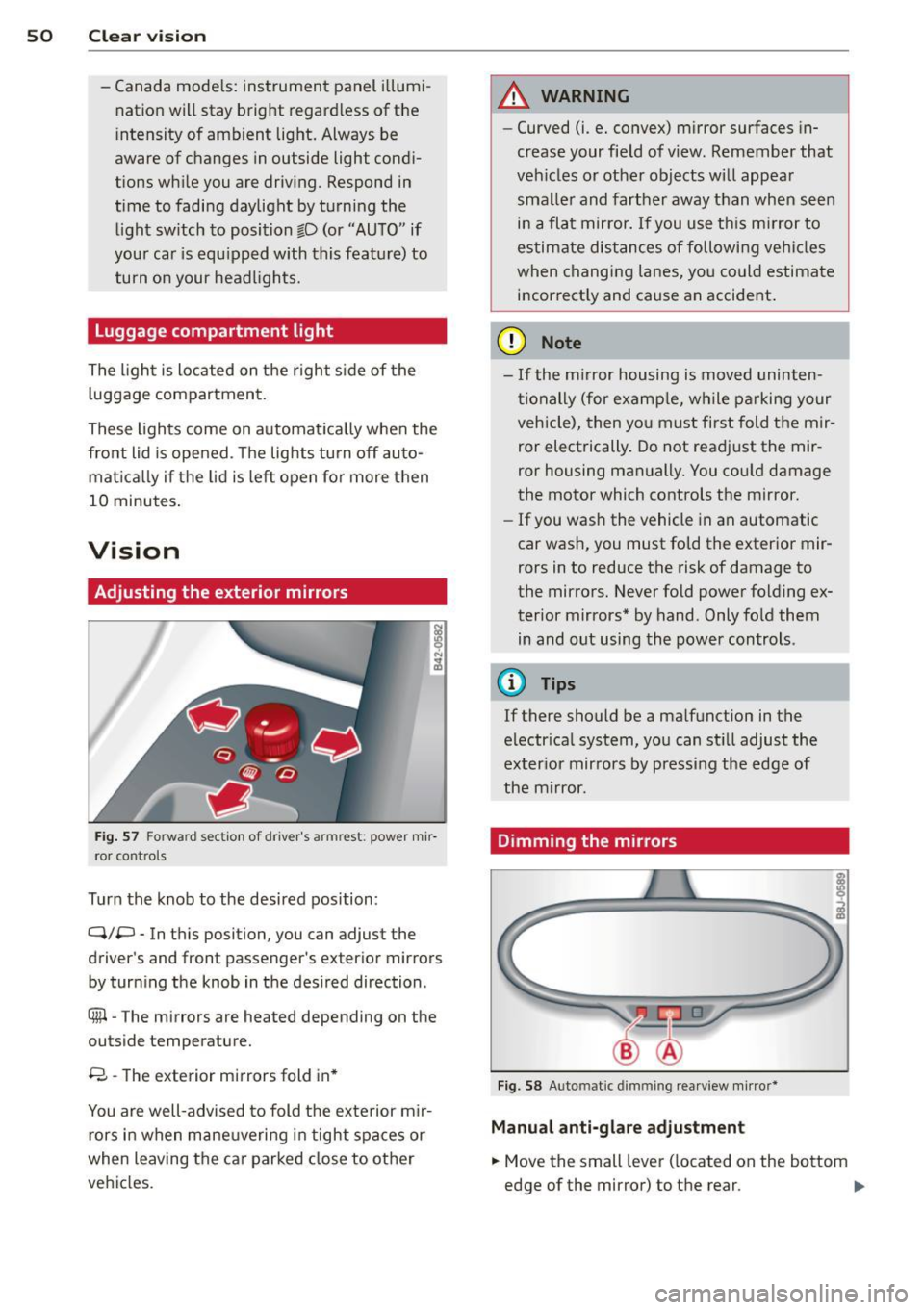
50 Clear vis ion
- Canada mode ls: instrument panel illumi
nation will stay bright regard less of the
i ntensity of amb ient light. Always be
aware of changes in outside light condi
tions whi le you are driv ing. Respond in
time to fading daylight by turning the light sw itch to position @,0 (or "AUTO " if
you r ca r is equ ipped with this feature) to
tu rn on your headl igh ts.
Luggage compartment light
The ligh t is loc ated on t he righ t side of the
l uggage compartmen t.
These lights come on automat ica lly when the
front lid is ope ned . T he lights tu rn off au to
mat ica lly if the lid is left open for more t hen
10 minutes .
Vision
Adjusting the exterior mirrors
Fig. 57 Forwa rd se cti on of drive r' s armr est: pow er mir
r o r co ntrols
Turn the knob to the desired position :
Q/P - In this position, you can adjust the
driver's and fron t passenger's exter ior mirrors
by turn ing t he knob in the des ired direction .
8 - The exterior mirrors fold in *
You are well-advised to fold the ex te rior m ir
rors in when mane uvering in tight spaces or
when leaving the car parked close to other
vehi cles .
A WARNING
--Curved (i.e . convex) m irror surfaces in-
crease your field of view. Remember that
veh icles or other objects will appea r
sma ller and farther away than when seen
i n a flat mirror.
If you use th is m irror to
estimate dis tances of followi ng ve hicl es
when changing lanes, yo u co uld estimate
i n correct ly and cause an accident .
(D Note
-If the m irror housing is moved uninten
ti onally (for examp le , while p arking your
vehicle), then yo u m ust first fold t he mir
ror electrically. Do not readjust the mir
ror housing manually . You cou ld damage
the motor which controls the mirror .
- If you wash the vehicle in an automatic
car wash, you must fo ld the exter ior mir
rors in to reduce the risk of damage to
the mirro rs . Never fold powe r folding ex
terior mirrors* by hand . Only fold them
in and o ut using the power controls .
@ Tips
If there should be a malf u nction in t he
electr ica l system, you can st ill adjust the
ex ter io r mirrors by pressing the edge of
the m irror.
Dimming the mirrors
Fig . 58 Auto matic dimmin g rearv iew m irro r*
Manu al anti-glare adju stment
.,. Move the small lever ( located on the bottom
edge of the mirror) to the rear .
Ill>
Page 53 of 244

Automatically dimming mirr ors*
• To d im the rearv iew mirror and both exterior
mirrors, press the @ button. The diode @
turns on. The rearview and exterior mirrors dim automat ically when light shines on
them, for example from headlights on ave hicle to the rear.
A WARNING
E lectrolyte flu id can leak from automatic
dimming m irrors if the glass is broken.
Electrolyte flu id can irritate skin, eyes and
respiratory system.
- Repeated or prolonged exposure to elec
tro lyte can cause irritation to the respira
tory system, espec ially among people
with asthma or other respiratory condi
tions . Get fresh air immediately by leav
ing the vehicle or, if that is not possible,
open windows and doors a ll the way.
- If electrolyte gets into the eyes, flush
them thoro ughly with large amounts of
clean water for at least 15 m inutes;
medica l attention is recommended.
- If electrolyte contacts sk in, flush affect
ed area with clean water for at least 15
minutes and then wash affected area
with soap and water; medical attention is recommended . Thoroughly wash af
fected clothing and shoes before reuse .
- If swallowed and person is conscious, rinse mouth w ith water for at least 15
minutes . Do not induce vom iting un less
instructed to do so by medical professio
nal. Get medical attention immediately.
(D Note
Liquid elect rolyte leaking from broken mir
ror glass will damage any p lastic surfaces
it comes i n contact w ith. Clean up spilled
elec trolyte immediately with clean water
and a sponge.
(D Tips
- Switch ing off the dimming func tion of
the i nside rear view m irror also deact i-
Clear vi sion 51
vates the automatic dimming function of
the exterior mirrors .
- T he automatic dimming mirrors do not
dim when the interior lighting is turned
on or the reverse gear is selected .
- Automatic d imm ing fo r the mirror on ly
operates properly if the light striking the
inside mirror is not hindered in any way.
, Sun visors
,.--~ --~-- -------.
Fig . 59 S un vi so r
The vanity mirrors in the sun visors are equip
ped with covers .
Wiper and washer
system
Windshield wiper
The windshield wiper lever controls both the
windshield wipers and the washer system.
Fig . 60 W iper le ver: win ds hiel d wiper le ver positio ns
The windshield wiper lever I:!) fig. 60 has th e
fo llowing positions:
Int ermittent wiping ~1 (acti vating r ain
s e n sor )*
• Move the lever up to position (!).
Page 54 of 244

52 Clear vis ion
• Move the interva l set switch @, to change
the interva ls.
Low wiper sp eed
• Move the leve r up to position @.
High wiper speed
• Move the lever up to position @.
One-touch wiping
• Move the lever to position@, when you
want to wipe the windshield briefly.
Automatic wiper /washer
• Pull the lever to position ® (toward the
steering wheel) and ho ld.
• Re lease the lever. The washer stops and the
wipers keep going for about four seconds .
Turning off the wipers
• Move the leve r back to position @.
The windshield wipers and washer only work when the ignition is turned on. If you switch
off the ignit ion w ith the windshield wiper lev
e r still in the interval wipe position and then
come back a while later and drive off, the rain
sensor will reactivate itse lf after the vehicle
speed has exceeded 4 mph (6 km/h).
The rain sensor* is only activated with the
wiper leve r set to posit ion
(D . When it starts
to rain, the rain sensor will automatically acti
vate the intermittent wiping mode.
To reduce the sens it iv ity of the se nsor, move
switch @down. To increase the sens itiv ity,
move the switch up. The highe r you adjust the
sens itivity, the faster the sensor wi ll react
when it se nses moisture on the windshield.
The pauses between w iper turns depend not
only on the sensitivity setting, but on the ve
h icle speed as well.
During brief stops, e .g. at a red light, wiper
motion wi ll automatica lly be reduced to the
next lower speed. Wipers already turning at
low speed change to interm ittent wip ing .
When the ignition is turned on, t he washer
jets are heated.
A WARNING
- W iper blades are crucial for safe driving!
O nly when they are i n good condit io n are
they able to clear the windows properly
to p rov ide uncomprom ising v is ibility.
Wo rn o r damaged wipe r blades are a
safety haz ard
~ page 54, Replacing
windshield wiper blades!
- The light/ rain sensor* is only des igned to
assis t and support the d river. It remains
entire ly the driver's responsibility to
monitor outside weather condit ions and
to manually activate the wipers as soon as rain or dr izzle reduces v is ibility
through the windshield.
- The windsh ield must not be treated w ith
water-repellent materials. They can in
crease glare under poor v is ibility condi
tions such as wetness, darkness, or when
the sun is low on the hor izon. In addi
tion, they can cause the w indshield w ip
ers to chatter.
(D Note
In freezing o r near freezing conditions:
- Always check that the w iper blades are
not frozen to the g lass before you turn
the wipers on. Loosen a wiper blade
w hich is frozen in place before operating
the wipe rs to prevent damage to the
w iper blade or the wiper motor.
- Do not use the w ipers to clear a frosted
w indow. Using the wipers as a conve n
ient ice scr ape r will dest roy the wipe r
blades.
- Before yo u take your ve hicle to a n auto
ma tic ca r w ash, ma ke s ure you have the
w indshield wiper system switched off
(lever in position 0), otherwise the wind
shield wiper system could get damaged
in the car wash i f it should suddenly
come on.
(D Tips
- The windshie ld wipers are switched off
when the ignit ion is turned off. Act ivate
the winds hield wipers after the ignition
Page 59 of 244
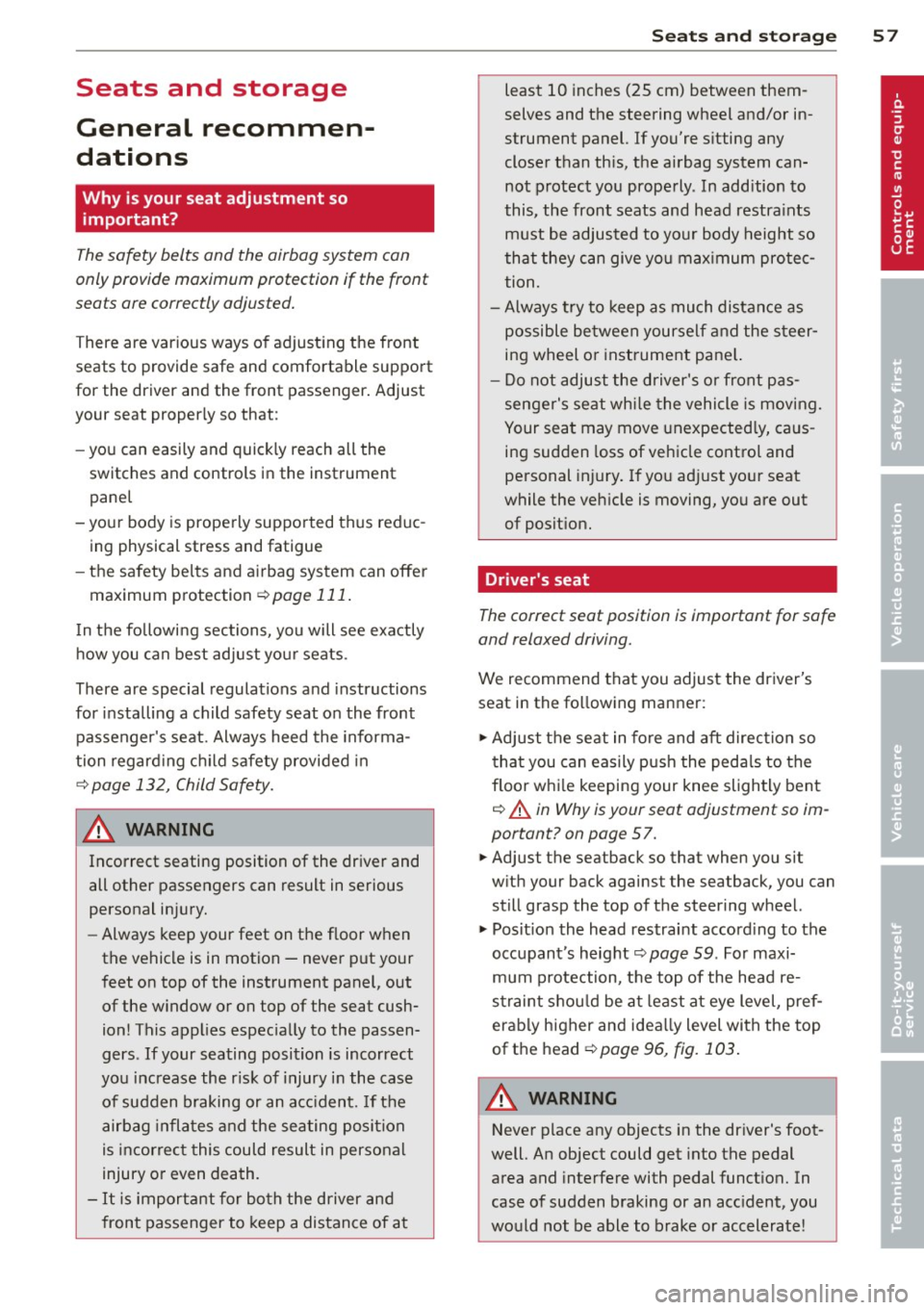
Seats and storage
General recommen
dations
Why is your seat adjustment so important?
The safety belts and the airbag system can
only provide maximum protection if the front
seats are correctly adjusted.
There are various ways of adjusting the front
seats to provide safe and comfortable support
for the driver and the front passenger. Adjust
your seat properly so that :
- you can easily and quick ly reach all the
switches and controls in the instrument
panel
- your body is properly supported thus reduc ing physical stress and fatigue
- the safety belts and airbag system can offe r
maximum protection
¢ page 111.
In the following sections, you will see exactly
how you can best adjust your seats .
There are special regulations and instructions
for installing a child safety seat on the front passenger's seat. Always heed the informa
tion regard ing child safety provided in
¢ page 132, Child Safety.
A WARNING
Incorrect seating position of the driver and
all other passengers can result in serious
personal injury.
- Always keep your feet on the f loor when
the vehicle is in motion -never p ut your
feet on top of the instrument panel, out
of the w indow or on top of the seat cush
ion! This applies espec ially to the passen
gers . If your seating position is incorrect
you increase the r isk of injury in the case
of sudden braking or an acc ident. If the
airbag inflates and the seating position
is incorrect this could result in personal
injury or even death.
- It is important for bo th the driver and
front passenger to keep a distance of a t
Seat s an d sto rage 57
least 10 inches (25 cm) between them
selves and the steering wheel and/or in
strument panel. If you're s itting any
closer than th is, the airbag system can
not protect you properly. In addition to
this, the front seats and head restra ints
must be adjusted to yo ur body height so
that they can give you max imum prote c
tion.
- Always try to keep as much distance as
possible be tween yourself and the s teer
ing wheel o r instrument pane l.
- Do not adjust the driver's or front pas
senger's seat whi le the vehicle is moving.
Your seat may move unexpected ly, caus
ing sudden loss of vehicle control and
personal injury . If you ad just yo ur seat
while the veh icle is moving, you are out
of posit ion.
Driver's seat
The correct seat position is important for safe
and relaxed driving.
We recommend that you adjust the driver's
seat in the fo llowing manner:
.,. Adj ust the seat in fore and aft direction so
t ha t you can easily push the peda ls to the
floor whi le keeping your knee sligh tly bent
c::> A in Why is your seat adjustment so im
portant? on page
57 .
.,. Adjust the seatback so that when you sit
w ith your back against the seatback, you can
still grasp the top of the steering wheel.
.,. Pos it ion the head restrai nt accord ing to the
occupant 's height
c::> page 59. For maxi
mum protection, the top of the head re
straint shou ld be at least at eye level, pref
erably higher and idea lly level with the top
of the head
¢ page 96, fig. 103 .
A WARNING
Never place any objects in the dr iver's foot
well. An object could get into the pedal
area and interfere with pedal funct ion. In
case of sudden braking or an acc ident, you
would not be able to brake or accelerate!
Page 60 of 244

58 Seats and storage
Front passenger's seat
Always move the front passenger seat into
the rearmost position .
To avoid contact with the airbag while it is de
ploying, do not sit any closer to the instru
ment panel than necessary and always wear
the three-point safety belt provided adjusted
correctly . We recommend that you adjust the
passenger's seat in the following manner:
• Bring the backrest up to an (almost) upright
pos it ion.
Do not ride with the seat reclined .
• The idea l position fo r the head restraint is
with the upper edge of the restraint leve l
with the top of your head ¢
page 59. You
shou ld
not lower the top of the restraint be
low the level of your eyes .
• Place your feet on the floor in front of the
passenger's seat .
Power seats
Adjustment switches
The operating logic for the switches corre
sponds to the construction and function of
the seat.
Fig. 65 Adjust men t swi tc h es : locat io ns on dr iver seat
The operating logic for the switches corre
sponds to the construction, the design and
the function of the seat. Push or pull either
switch in exactly the same d irect ion you want
the corresponding part of the seat to move.
Adjustment switches
CD Adjusting the lumbar support
@ Adjusting seat height and fore-and-aft po
sition @
Adjusting the angle of the seatback
Power seat adjustment
The switches can be moved in various direc
tions to allow precis e adjustment .
Read and heed all warnings before you adjust
your seat.
¢ &_ .
Adjusting the curvature of the lumbar
support
• Push the forward or rear depression on the
switch shell
CD C? page 58, fig. 65 to in
crease or decrease the back rest curvature.
Adjusting the height of the lumbar
support
• Push the top or bottom depression on the
sw itch shell
CD to raise or lower the support
in the backrest.
Moving the front seats forward or
backward
• Press the switch@ forward or backward
horizontally .
Adjusting the seat height
• Pull or p ush the switch @evenly at both
ends to raise or lower the seat.
Angling the seat cushion up and down
(front)
• Pull or push the switch @at the front only
to raise or lowe r the seat.
Angling the seat cushion up and down
(rear)
• Pull or push the switch @at the rear only to
raise or lower the seat.
Adjusting the seatback
• Push or pull the switch @ in the same direc
tion you want the seatback to tilt.
A WARNING "---
- Never adjust the driver's or front passen-
ger seat while the vehicle is moving . If
you do this while the vehicle is moving,
~
Page 63 of 244
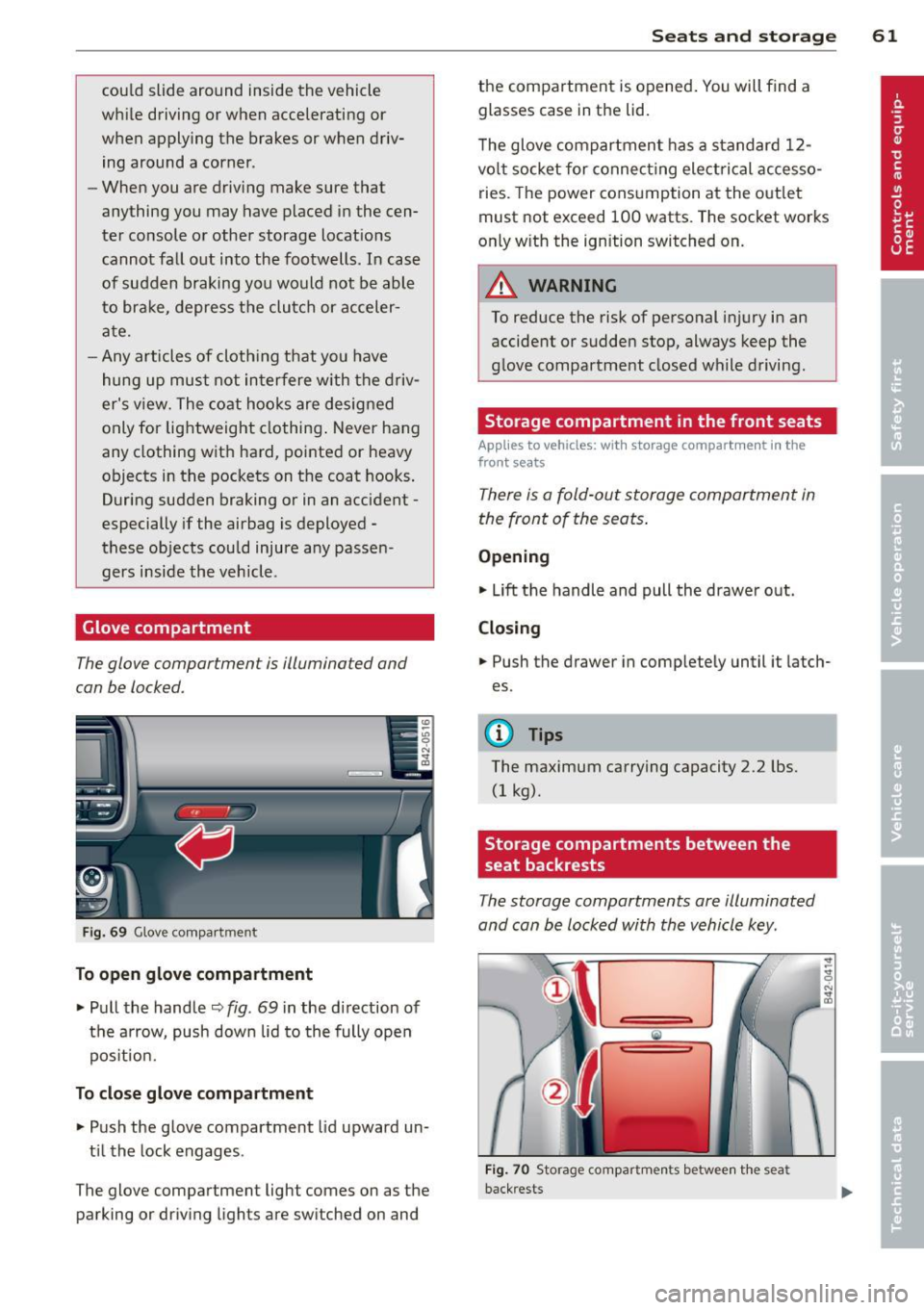
could slide around inside the vehicle
wh ile driving or when accelerating or
when applying the brakes or when driv
ing around a corner .
- When you are driving make sure that
anything you may have placed in the cen
ter console or other storage locations
cannot fa ll out into the footwells . In case
of sudden braking you would not be able
to brake, depress the clutch or acceler
ate.
- Any articles of cloth ing that you have
hung up must not interfere with the driv
er's v iew. The coat hooks are designed
only for lightweight clothing. Never hang
any clothing with hard, pointed or heavy
objects in the pockets on the coat hooks .
During sudden braking or in an accident -
especially if the airbag is deployed -
these objects could injure any passen
gers inside the veh icle .
Glove compartment
The glove compartment is illuminated and
can be locked.
Fig. 69 Glove compar tme nt
To open glove compartment
• Pull the handle ~ fig . 69 in the direction of
the arrow, push down lid to the fully open
pos it ion .
To close glove compartment
• Push the glove compartment lid upward un
t il the lock engages .
The glove compartment light comes on as the parking or driving lights are switched on and
Seats and storage 61
the compartment is opened . You will find a
glasses case in the lid.
T he glove compartment has a standard
12-
volt socket for connecting electrical accesso
ries. The power consumption at the outlet
must not exceed 100 watts. The socket works
only w ith the ignition switched on.
_& WARNING
To reduce the risk of personal injury in an
accident or sudden stop, always keep the
g love compartment closed while driving.
Storage compartment in the front seats
Applies to vehicles: with storage compartment in the
front seats
There is a fold-out storage compartment in
the front of the seats .
Opening
• Lift the handle and pull the drawer out.
Closing
-
• Push the drawer in completely until it latch
es.
(D Tips
The maximum carrying capacity 2.2 lbs.
(1 kg).
Storage compartments between the
, seat backrests
The storage compartments are illuminated
and can be locked with the vehicle key.
F ig . 70 Storage compartments betwee n the seat
back rests
Page 73 of 244
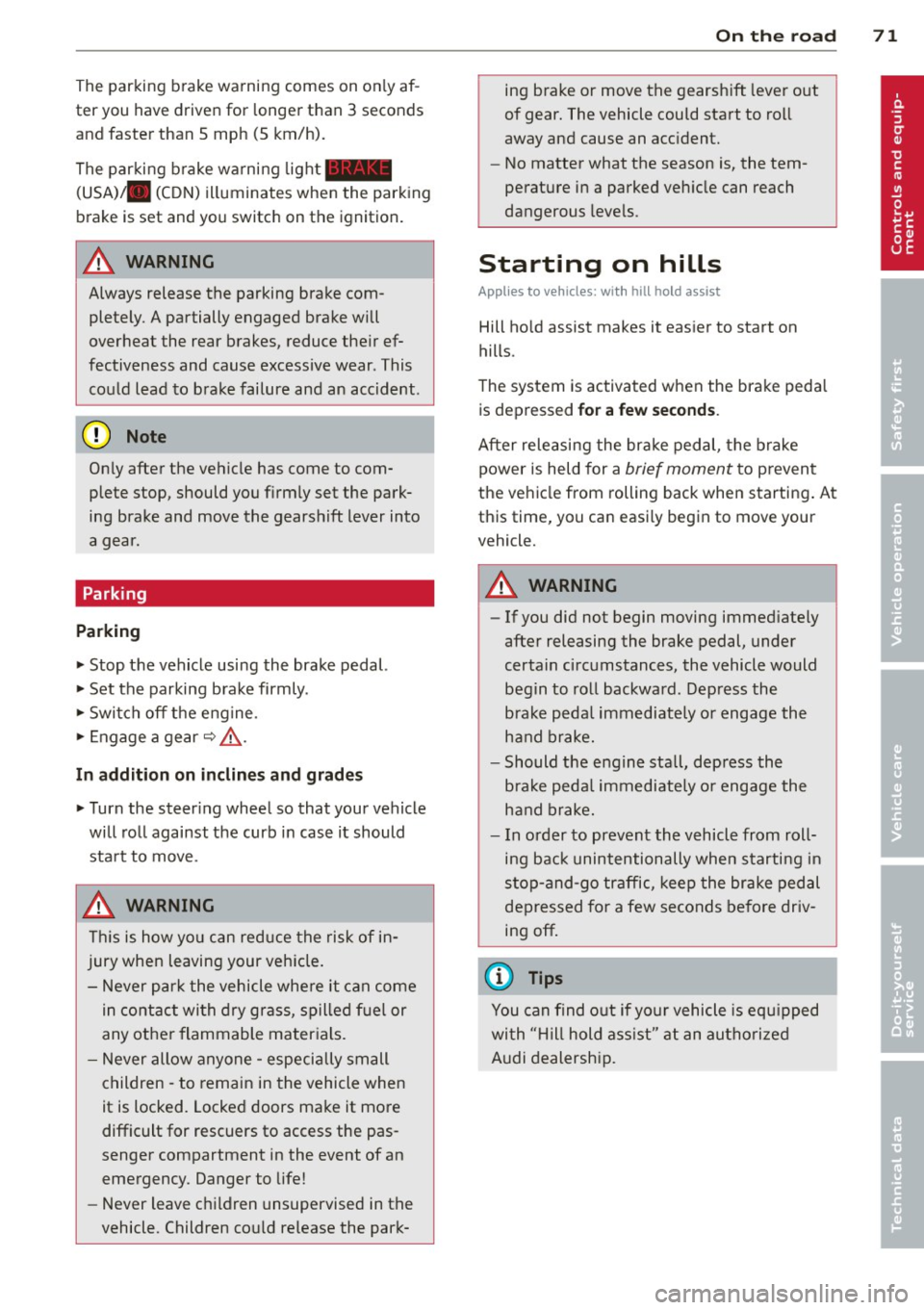
The parking brake warning comes on only af
ter you hav e drive n for longer than 3 seconds
and faster than 5 mph (5 km/h).
The parking b rake warning light _
(USA)/ . (CON) illuminates when the parking
brake is set and you switc h on the ignition .
A WARNING
Always release the parking brake com
pletely. A partially engaged brake will
overheat the rear brakes, reduce the ir ef
fectiveness and cause excess ive wear . This
could lead to brake failure and an accident .
On ly after the vehicle has come to com
plete stop, should you f irm ly set the park
ing brake and move the gearshift lever into
a gear.
Parking
Parking
"' Stop the vehicle using the brake pedal.
"' Set the parking brake firmly.
"' Swi tch off the e ngine .
"' Engage a gear
~ ,&. .
In addition on inclines and grad es
"' Turn the steer ing whee l so that your vehicle
will ro ll against the curb i n case it should
sta rt to move .
A WARNING
This is how yo u can reduce the risk of in
jury when leaving your veh icle.
- Never pa rk the vehicle whe re it can come
in contac t wi th dry grass, spille d fu el or
any othe r flammable materials.
- Never allow a nyone - especially small
children -to remain in the vehicle when
it is locked. Locked doors ma ke it mo re
difficult for rescuers to access the pas
senger compartment in the event of an emergency . Danger to life!
- Never leave c hildren unsupervised in the
vehicle . Children co uld re lease the park-
-
On th e ro ad 71
ing brake or move the gearsh ift leve r out
of gear. The vehicle could start to ro ll
away and cause an acc ident.
- No matter what the season is, the tem
perature in a parked ve hicle can reach
dangerous leve ls.
Starting on hills
App lies to vehicles : wi th hill ho ld assist
Hill ho ld assist makes it eas ier to start on
hill s.
The system is activated when the brake peda l
is depressed
for a few second s.
After releasing the brake ped al, the brake
power is held for a
brief moment t o p reven t
the ve hicle from rolling back when starting . A t
this time, you can easi ly begin to move your
vehicle.
A WARNING
- If you did not begin moving immed iate ly
after releasing the brake pedal, under
certa in circumstances, the vehicle would
begin to roll backwa rd . Dep ress the
brake peda l imm ediate ly o r engage the
hand b rake.
- Should t he eng in e sta ll, dep ress th e
bra ke peda l immediate ly o r engage the
ha nd br ake.
- In o rder to prevent the vehicl e from roll
ing back unintentionally whe n starti ng in
s top-and-go tr affic, keep the br ake ped al
depressed fo r a few seconds be fore driv
in g off .
(D Tips
You can find o ut if yo ur vehicle is equ ipped
wi th "Hi ll hold ass ist" at a n au thori ze d
A udi dealersh ip.